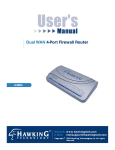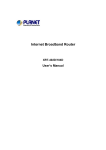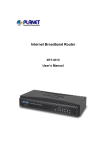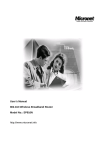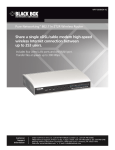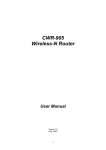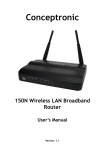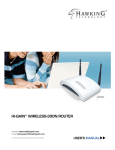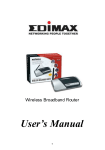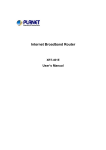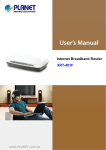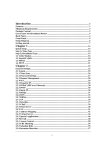Download Planet Technology XRT-412 User's Manual
Transcript
Internet Broadband Router XRT-412 User’s Manual 1 Copyright Copyright (C) 2006 PLANET Technology Corp. All rights reserved. The products and programs described in this User’s Manual are licensed products of PLANET Technology, This User’s Manual contains proprietary information protected by copyright, and this User’s Manual and all accompanying hardware, software, and documentation are copyrighted. No part of this User’s Manual may be copied, photocopied, reproduced, translated, or reduced to any electronic medium or machine-readable form by any means by electronic or mechanical. Including photocopying, recording, or information storage and retrieval systems, for any purpose other than the purchaser's personal use, and without the prior express written permission of PLANET Technology. Disclaimer PLANET Technology does not warrant that the hardware will work properly in all environments and applications, and makes no warranty and representation, either implied or expressed, with respect to the quality, performance, merchantability, or fitness for a particular purpose. PLANET has made every effort to ensure that this User’s Manual is accurate; PLANET disclaims liability for any inaccuracies or omissions that may have occurred. Information in this User’s Manual is subject to change without notice and does not represent a commitment on the part of PLANET. PLANET assumes no responsibility for any inaccuracies that may be contained in this User’s Manual. PLANET makes no commitment to update or keep current the information in this User’s Manual, and reserves the right to make improvements to this User’s Manual and/or to the products described in this User’s Manual, at any time without notice. If you find information in this manual that is incorrect, misleading, or incomplete, we would appreciate your comments and suggestions. FCC Compliance Statement This equipment generates and uses radio frequency energy and if not installed and used properly, that is, in strict accordance with the instructions provided with the equipment, may cause interference to radio and TV communication. The equipment has been tested and found to comply with the limits for a Class A computing device in accordance with the specifications in Subpart B of Part 15 of FCC rules, which are designed to provide reasonable protection against such interference in a residential installation. However, there is no guarantee that interference will not occur in a particular installation. If you suspect this equipment is causing interference, turn your Ethernet Switch on and off while your radio or TV is showing interference, if the interference disappears when you turn your Ethernet Switch off and reappears when you turn it back on, there is interference being caused by the Ethernet Switch. You can try to correct the interference by one or more of the following measures: Reorient the receiving radio or TV antenna where this may be done safely. To the extent possible, relocate the radio, TV or other receiver away from the Switch. Plug the Ethernet Switch into a different power outlet so that the Switch and the receiver are on different branch circuits. If necessary, you should consult the place of purchase or an experienced radio/television technician for additional suggestions. CE mark Warning The is a class B device, In a domestic environment, this product may cause radio interference, in which case the user may be required to take adequate measures. 2 Trademarks The PLANET logo is a trademark of PLANET Technology. This documentation may refer to numerous hardware and software products by their trade names. In most, if not all cases, these designations are claimed as trademarks or registered trademarks by their respective companies. WEEE To avoid the potential effects on the environment and human health as a result of the presence of hazardous substances in electrical and electronic equipment, end users of electrical and electronic equipment should understand the meaning of the crossed-out wheeled bin symbol. Do not dispose of WEEE as unsorted municipal waste and have to collect such WEEE separately. Revision User’s Manual for PLANET Internet Broadband Router: Model: XRT-412 Rev: 1 (April 2006) Part No.: EM-XRT412v1 3 TABLE OF CONTENTS Chapter 1 Introduction .......................................................................................1 1.1 Features ......................................................................................................1 1.2 Minimum Requirements...............................................................................1 1.3 Package Contents .......................................................................................1 1.4 Get to know XRT-412 ..................................................................................2 1.5 Setup Diagram ............................................................................................3 1.6 Getting started.............................................................................................4 Chapter 2 Quick Setup .....................................................................................12 2.1 Cable Modem ............................................................................................14 2.2 Fixed-IP xDSL ...........................................................................................15 2.3 PPPoE.......................................................................................................16 2.4 PPTP .........................................................................................................18 2.5 L2TP..........................................................................................................20 2.6 Telstra Big Pond........................................................................................22 Chapter 3 General Settings..............................................................................24 3.1 System ......................................................................................................25 3.1.1 Time Zone...........................................................................................25 3.1.2 Password Settings ..............................................................................26 3.1.3 Remote Management .........................................................................27 3.2 WAN ..........................................................................................................28 3.2.1 Dynamic IP .........................................................................................29 3.2.2 Static IP Address ................................................................................29 3.2.3 PPPoE (PPP over Ethernet) ...............................................................29 3.2.4 PPTP ..................................................................................................29 3.2.5 L2TP ...................................................................................................29 3.2.6 Telstra Big Pond .................................................................................29 3.2.7 DNS ....................................................................................................29 3.2.8 DDNS..................................................................................................30 3.3 LAN ...........................................................................................................31 3.4 NAT ...........................................................................................................32 3.4.1 Port Forwarding ..................................................................................34 3.4.2 Virtual Server ......................................................................................35 3.4.3 Special Applications............................................................................36 3.4.4 UPnP Settings ....................................................................................38 3.4.5 ALG Settings.......................................................................................39 3.5 Firewall ......................................................................................................40 3.5.1 Access Control....................................................................................41 3.5.2 URL Blocking ......................................................................................44 3.5.3 Denial of Service (DoS) ......................................................................45 3.5.4 DMZ ....................................................................................................45 3.6 Print Server ...............................................................................................47 Chapter 4 Status ...............................................................................................53 4.1 Status and Information ..............................................................................53 4.2 Internet Connection ...................................................................................54 4 4.3 Device Status ............................................................................................54 4.4 System Log ...............................................................................................55 4.5 Security Log ..............................................................................................56 4.6 Active DHCP Client ...................................................................................56 4.7 Statistics ....................................................................................................57 Chapter 5 Tools.................................................................................................58 5.1 Configuration Tools ...................................................................................58 5.2 Firmware Upgrade.....................................................................................59 5.3 Reset .........................................................................................................60 Appendix A........................................................................................................61 Glossary ............................................................................................................63 5 Chapter 1 Introduction Congratulations on purchasing PLANET XRT-412. This Broadband Router is an IP Sharing Router that enables multiple users to share the Internet through an ADSL or cable modem. Simply configure your Internet connection settings in the Broadband Router and plug your PC to the LAN port and you're ready to share files and access the Internet. As your network grows, you can connect another hub or switch to the router’s LAN ports, allowing you to easily expand your network. It provides a total solution for the Small and Medium-sized Business (SMB) and the Small Office/Home Office (SOHO) markets, giving you an instant network today, and the flexibility to handle tomorrow's expansion and speed. Built-in with dual USB ports can share two printers to LAN user for the printing service. 1.1 Features • • • • • • • • • • • • High Internet Access throughput Allow multiple users to share a single Internet line Supports up to 253 users Provides two USB port for connecting with USB printer. Internet Access via Cable or xDSL modem Access Private LAN Servers from the Public Network Equipped with four LAN ports (10/100M) and one WAN port (10/100M) Support DHCP (Server/Client) for easy setup Support advance features such as: Special Applications, DMZ, Virtual Servers, Access Control, and Firewall. Allow you to monitor the router’s status such as: DHCP Client Log, Security Log and Device/Connection Status Easy to use Web-based GUI for configuration and management purposes Remote Management allows configuration and upgrades from a remote site (over the Internet) 1.2 Minimum Requirements • • • One External xDSL (ADSL) or Cable modem with an Ethernet port (RJ-45) Network Interface Card (NIC) for each Personal Computer (PC) PCs with a Web-Browser (Internet Explorer 4.0 or higher, or Netscape Navigator 4.7 or higher) 1.3 Package Contents • • • • One XRT-412D unit One Quick Installation Guide One User Manual CD One Power Adapter "Note The WAN “idle timeout” auto-disconnect function may not work due to abnormal activities of some network application software; computer virus or hacker attacks 1 from the Internet. For example, some software sends network packets to the Internet in the background, even when you are not using the Internet. So please turn off your computer when you are not using it. This function also may not work with some ISP. So please make sure this function can work properly when you use this function in the first time, especially when your ISP charge you by time used. 1.4 Get to know XRT-412 Back Panel The diagram (fig1.0) below shows XRT-412’s back panel. The router’s back panel is divided into three sections, LAN (1,2,3,4), WAN, USB and Reset: Figure 1.0 1) Local Area Network (LAN) XRT-412’s 4 LAN ports are where you connect your LAN’s PCs, printer servers, hubs and switches etc. 2) Wide Area Network (WAN) The WAN port is the segment connected to your xDSL or Cable modem and is linked to the Internet. 3) USB The USB ports are the place that the printers connect to, LAN user can access the printers after installing the utility. 4) Reset The Reset button allows you to do one of two things. 1) If problems occur with your router, press the router’s reset button with a pencil tip (for less than 4 seconds) and the router will re-boot itself, keeping your original configurations. 2) If problems persist or you experience extreme problems or you forgot your password, press the reset button for longer than 4 seconds and the router will reset itself to the factory default settings (warning: your original configurations will be replaced with the factory default settings) Front Panel On XRT-412’s front panel there are LED lights that inform you of machine current status. Below is an explanation of each LED and its description. 2 LED Light Status Description PWR ON Router’s power supply is on USB1 Flash OFF Flash OFF Data is transmitting No data transmitted Data is transmitting No data transmitted ON OFF ON OFF Flashing WAN port 100Mbps is connected WAN port 10Mbps is connected WAN is connected No WAN connection WAN port has Activity (ACT), data being sent ON OFF ON OFF Flashing LAN port 100Mbps is connected LAN port 10Mbps is connected LAN is connected No LAN connection LAN port has Activity (ACT), data being sent USB2 WAN 10/100M WAN LNK/ACT LAN 10/100M (Port 1-4) LAN LNK/ACT (Port 1-4) 1.5 Setup Diagram Figure 1.2 below shows a typical setup for a Local Area Network (LAN). Figure 1.2 3 1.6 Getting started This is a step-by-step instruction on how to start using the router and get connected to the Internet. 1) Setup your network as shown in the setup diagram above (fig 1.2). 2) You then need to set your LAN PC clients so that it can obtain an IP address automatically. All LAN clients require an IP address. Just like an address, it allows LAN clients to find one another. Configure your PC to obtain an IP address automatically By default XRT-412’s DHCP is on, this means that you can obtain an IP address automatically once you’ve configured your PC to obtain an IP address automatically. This section will show you how to configure your PC’s so that it can obtain an IP address automatically for either Windows 95/98/Me, 2000 or NT operating systems. For other operating systems (Macintosh, Sun, etc.), follow the manufacturer’s instructions. The following is a step-by-step illustration on how to configure your PC to obtain an IP address automatically for 2a) Windows 95/98/Me, 2b) Windows XP, 2c) Windows 2000 and 2d) Windows NT. 2a) Windows 95/98/Me 1: Click the Start button and select Settings, then click Control Panel. The Control Panel window will appear. 2: Double-click Network icon. The Network window will appear. 3: Check your list of Network Components. If TCP/IP is not installed, click the Add button to install it now. If TCP/IP is installed, go to step 6. 4: In the Network Component Type dialog box, select Protocol and click Add button. 5: In the Select Network Protocol dialog box, select Microsoft and TCP/IP and then click the OK button to start installing the TCP/IP protocol. You may need your Windows CD to complete the installation. 6: After installing TCP/IP, go back to the Network dialog box. Select TCP/IP from the list of Network Components and then click the Properties button. 7: Check each of the tabs and verify the following settings: • • • • • Bindings: Check Client for Microsoft Networks and File and printer sharing for Microsoft Networks. Gateway: All fields are blank. DNS Configuration: Select Disable DNS. WINS Configuration: Select Disable WINS Resolution. IP Address: Select Obtain IP address automatically. 4 8: Reboot the PC. Your PC will now obtain an IP address automatically from your Broadband Router’s DHCP server. " Note: Please make sure that XRT-412’s DHCP server is the only DHCP server available on your LAN. Once you’ve configured your PC to obtain an IP address automatically, please proceed to Step 3 2b) Windows XP 1: Click the Start button and select Settings, then click Network Connections. The Network Connections window will appear. 2: Double-click Local Area Connection icon. The Local Area Connection window will appear. 3: Check your list of Network Components. You should see Internet Protocol [TCP/IP] on your list. Select it and click the Properties button. 4: In the Internet Protocol (TCP/IP) Properties window, select Obtain an IP address automatically and Obtain DNS server address automatically as shown on the following screen. 5 5: Click OK to confirm the setting. Your PC will now obtain an IP address automatically from your Broadband Router’s DHCP server. " Note: Please make sure that XRT-412’s DHCP server is the only DHCP server available on your LAN. Once you’ve configured your PC to obtain an IP address automatically, please proceed to Step 3. 2c) Windows 2000 1: Click the Start button and select Settings, then click Control Panel. The Control Panel window will appear. 2: Double-click Network and Dial-up Connections icon. In the Network and Dial-up Connection window, double-click Local Area Connection icon. The Local Area Connection window will appear. 3: In the Local Area Connection window, click the Properties button. 4: Check your list of Network Components. You should see Internet Protocol [TCP/IP] on your list. Select it and click the Properties button. 6 5: In the Internet Protocol (TCP/IP) Properties window, select Obtain an IP address automatically and Obtain DNS server address automatically as shown on the following screen. 6: Click OK to confirm the setting. Your PC will now obtain an IP address automatically from your Broadband Router’s DHCP server. " Note: Please make sure that XRT-412’s DHCP server is the only DHCP server available on your LAN. Once you’ve configured your PC to obtain an IP address automatically, please proceed to Step 3. 2d) Windows NT 1: Click the Start button and select Settings, then click Control Panel. The Control Panel window will appear. 2: Double-click Network icon. The Network window will appear. Select the Protocol tab from the Network window. 3: Check if the TCP/IP Protocol is on your list of Network Protocols. If TCP/IP is not installed, click the Add button to install it now. If TCP/IP is installed, go to step 5. 7 4: In the Select Network Protocol window, select the TCP/IP Protocol and click the Ok button to start installing the TCP/IP protocol. You may need your Windows CD to complete the installation. 5: After you install TCP/IP, go back to the Network window. Select TCP/IP from the list of Network Protocols and then click the Properties button. 6: Check each of the tabs and verify the following settings: • IP Address: Select Obtain an IP address from a DHCP server. • DNS: Let all fields are blank. • WINS: Let all fields are blank. • Routing: Let all fields are blank. 7: Click OK to confirm the setting. Your PC will now obtain an IP address automatically from your Broadband Router’s DHCP server. " Note: Please make sure that XRT-412’s DHCP server is the only DHCP server available on your LAN. Once you’ve configured your PC to obtain an IP address automatically, please proceed to Step 3. 8 3) Once you have configured your PCs to obtain an IP address automatically, the router’s DHCP server will automatically give your LAN clients an IP address. By default XRT-412’s DHCP server is enabled so that you can obtain an IP address automatically. To see if you have obtained an IP address, see Appendix A. Note: Please make sure that XRT-412’s DHCP server is the only DHCP server available on your LAN. If there is another DHCP on your network, then you’ll need to switch one of the DHCP servers off. (To disable XRT-412’s DHCP server see chapter 2 LAN Port) 4) Once your PC has obtained an IP address from your router, enter the default IP address 192.168.0.1 (broadband router’s IP address) into your PC’s web browser and press <enter> 5) The login screen below will appear. Enter the “User Name” and “Password” and then click <OK> to login. Note: By default the user name is “admin” and the password is “1234”. For security reasons it is recommended that you change the password as soon as possible (in General setup/system/password, see chapter 2) 6) The HOME page screen below will appear. The Home Page is divided into four sections, Quick Setup Wizard, General Setup, Status Information and Tools. Quick Setup Wizard (Chapter 2) If you only want to start using XRT-412 as an Internet Access device then you ONLY need to configure the screens in the Quick Setup Wizard section. General Setup (Chapter 3) If you want to use more advanced features that XRT-412 has to offer, then you’ll need to configure the Quick Setup Wizard and the General Setup section. Alternatively, you can just configure the General Setup section, since the General Setup/WAN and the Quick Setup Wizard contain the same configurations. Status Information (Chapter 4) 9 The Status Information section is for you to monitor the router’s current status information only. Tools (Chapter 5) If you want to Reset the router (because of problems) or save your configurations or upgrade the firmware then the Tools section is the place to do this. Menu Description Quick Setup Wizard (Chapter 2) Select your Internet connection type and then input the configurations needed to connect to your Internet Service Provider (ISP). General Setup (Chapter 3) This section contains configurations for XRT412’s advance functions such as: Address Mapping, Virtual Server, Access Control, Hacker Attack Prevention, DMZ, Special applications and other functions to meet your LAN requirements. Status Information (Chapter 4) In this section you can see XRT-412's system information, Internet Connection, Device Status, Security Log and DHCP client Log information. Tools (Chapter 5) This section contains XRT-412’s Tools - Tools include Configuration tools, Firmware upgrade and Reset. Configuration tools allow you to Backup (save), Restore, or Restore to Factory Default configuration for your Broadband router. The Firmware upgrade tool allows you to upgrade your Broadband router's firmware. The RESET tool allows you to reset your Broadband router. 10 7) Click on Quick Setup Wizard (see chapter 2) to start configuring settings required by your ISP so that you can start accessing the Internet. The other sections (General Setup, Status Information and Tools) do not need to be configured unless you wish to implement/monitor more advance features/information. Select the section (Quick Setup Wizard, General Setup, Status Information and Tools) you wish to configure and proceed to the corresponding chapter. Use the selections on the web management’s top right hand page to navigate around the web-based management User Interface. 11 Chapter 2 Quick Setup The Quick Setup section is designed to get you using XRT-412 as quickly as possible. In the Quick Setup you are required to fill in only the information necessary to access the Internet. Once you click on the Quick Setup Wizard in the HOME page, you should see the screen below. Step 1) Time Zone The Time Zone allows your router to base its time on the settings configured here, this will affect functions such as Log entries and Firewall settings. Parameter Description Set Time Zone Select the time zone of the country you are currently in. The router will set its time based on your selection. Time Server Address You can manually assign time server address if the default time server does not work. Enable Daylight Savings The router can also take Daylight savings into account. If you wish to use this function, you must check/tick the enable box to enable your daylight saving configuration (below). Daylight Savings Select the period in which you wish to start and end the daylight Savings Time Click on NEXT to proceed to the next page (step 2) Broadband Type. Step 2) Broadband Type In this section you have to select one of four types of connections that you will be using to connect your broadband router’s WAN port to your ISP (see screen below). 12 " Note: Different ISP’s require different methods of connecting to the Internet, please check with your ISP as to the type of connection it requires. Menu Description 2.1 Cable Modem Your ISP will automatically give you an IP address 2.2 Fixed-IP xDSL Your ISP has given you an IP address already 2.3 PPPoE Your ISP requires you to use a Point-to-Point Protocol over Ethernet (PPPoE) connection. 2.4 PPTP Your ISP requires you to use a Point-to-Point Tunneling Protocol (PPTP) connection. 2.5 L2TP Layer 2 Tunneling Protocol is a common connection method used in xDSL connections. 2.6 Telstra Big Pond Telstra Big Pond is an Internet service is provided in Australia. Click on one of the WAN type and then proceed to the manual’s relevant sub-section (2.1, 2.2, 2.3, 2.4, 2.5 or 2.6). Click on Back to return to the previous screen. 13 2.1 Cable Modem Choose Cable Modem if your ISP will automatically give you an IP address. Some ISP’s may also require that you fill in additional information such as Host Name and MAC address (see screen below). " Note: The Host Name and MAC address section is optional and you can skip this section if your ISP does not require these settings for you to connect to the Internet. Parameters Description Host Name If your ISP requires a Host Name, type in the host name provided by your ISP, otherwise leave it blank if your ISP does not require a Host Name. MAC Address Your ISP may require a particular MAC address in order for you to connect to the Internet. This MAC address is the PC’s MAC address that your ISP had originally connected your Internet connection to. Type in this MAC address in this section or use the Clone MAC Address button to replace the WAN MAC address with the MAC address of that PC (you have to be using that PC for the Clone MAC Address button to work). If necessary, you can use the Release and Renew buttons to release and renew the WAN IP address. Host Name If your ISP requires a Host Name, type in the host name provided by your ISP, otherwise leave it blank if your ISP does not require a Host Name. Click <OK> when you have finished the configuration above. Congratulations! You have completed the configuration for the Cable Modem connection. You can start using the router now, if you wish to use some of the advance features supported by this router see chapter 3, 4, 5. 14 2.2 Fixed-IP xDSL Select Fixed-IP xDSL if your ISP has given you a specific IP address for you to use. Your ISP should provide all the information required in this section. Parameters Description IP This is the IP address that your ISP has given you. Subnet Mask Enter the Subnet Mask provided by your ISP. Gateway This is the ISP’s IP address gateway. DNS This is the ISP’s DNS server IP address. TTL Select Enable to plus 1 count in TTL response when user try to ping Internet IP address from LAN. By default, the feature sets to Disable. MAC Address Your ISP may require a particular MAC address in order for you to connect to the Internet. This MAC address is the PC’s MAC address that your ISP had originally connected your Internet connection to. Type in this MAC address in this section or use the Clone MAC Address button to replace the WAN MAC address with the MAC address of that PC (you have to be using that PC for the Clone MAC Address button to work). If necessary, you can use the Release and Renew buttons to release and renew the WAN IP address. Click <OK> when you have finished the configuration above. Congratulations! You have completed the configuration for the Fixed-IP x DSL connection. You can start using the router now, if you wish to use some of the advance features supported by this router see chapter 3, 4, 5. 15 2.3 PPPoE Select PPPoE if your ISP requires the PPPoE protocol to connect you to the Internet. Your ISP should provide all the information required in this section. Parameter Description User Name Enter the User Name provided by your ISP for the PPPoE connection Password Enter the Password provided by your ISP for the PPPoE connection Service Name This is optional. Enter the Service name if your ISP requires it, otherwise leave it blank. MTU This is optional. You can specify the maximum size of your transmission packet to the Internet. Leave it as it is if you do not wish to set a maximum packet size Connection Type If you select “Continuous”, the router will always connect to the ISP. If the WAN line breaks down and links again, the router will auto reconnect to the ISP. If you select “Connect on Demand”, the router will auto-connect to the ISP when someone wants to use the Internet and keep connected until the WAN idle timeout. The router will close the WAN connection if the time period that no one is using the Internet exceeds the “Idle Time”. If you select “Manual”, the router will connect to ISP only when you click “Connect” manually from the Web user interface. The WAN connection will not disconnect due to the idle timeout. If the 16 WAN line breaks down and latter links again, the router will not auto-connect to the ISP. Idle Time You can specify an idle time threshold (minutes) for the WAN port. This means if no packets have been sent (no one using the Internet) during this specified period, the router will automatically disconnect the connection with your ISP. TTL Select Enable to plus 1 count in TTL response when user try to ping Internet IP address from LAN. By default, the feature sets to Disable. Click <OK> when you have finished the configuration above. Congratulations! You have completed the configuration for the PPPoE connection. You can start using the router now, if you wish to use some of the advance features supported by this router see chapter 3, 4, 5. 17 2.4 PPTP Select PPTP if your ISP requires the PPTP protocol to connect you to the Internet. Your ISP should provide all the information required in this section. Parameter Description Obtain an IP address Automatically The ISP requires you to obtain an IP address by DHCP before connecting to the PPTP server. Use the following IP Address The ISP gives you a static IP to be used to connect to the PPTP server. IP address This is the IP address that your ISP has given you to establish a PPTP connection. Subnet Mask Enter the Subnet Mask provided by your ISP (e.g. 255.255.255.0) Default Gateway Enter the IP address of the ISP Gateway. User ID Enter the User Name provided by your ISP for the PPTP connection. Sometimes called a Connection ID. 18 Password Enter the Password provided by your ISP for the PPTP connection. PPTP Gateway If your LAN has a PPTP gateway, then enter that PPTP gateway IP address here. If you do not have a PPTP gateway then enter the ISP’s Gateway IP address above. Connection ID This is the ID given by ISP. This is optional. MTU This is optional. You can specify the maximum size of your transmission packet to the Internet. Leave it as it is if you do not wish to set a maximum packet size. BEZEQ-ISRAEL Select this item if you are using the service provided by BEZEQ in Israel. Connection Type If you select “Continuous”, the router will always connect to the ISP. If the WAN line breaks down and links again, the router will auto reconnect to the ISP. If you select “Connect on Demand”, the router will auto-connect to the ISP when someone wants to use the Internet and keep connected until the WAN idle timeout. The router will close the WAN connection if the time period that no one is using the Internet exceeds the “Idle Time”. If you select “Manual”, the router will connect to ISP only when you click “Connect” manually from the Web user interface. The WAN connection will not disconnect due to the idle timeout. If the WAN line breaks down and latter links again, the router will not auto-connect to the ISP. Idle Time Out You can specify an idle time threshold (minutes) for the WAN port. This means if no packets have been sent (no one using the Internet) throughout this specified period, then the router will automatically disconnect the connection with your ISP. Click <OK> when you have finished the configuration above. Congratulations! You have completed the configuration for the PPTP connection. You can start using the router now, if you wish to use some of the advance features supported by this router see chapter 3, 4, 5. 19 2.5 L2TP Select L2TP if your ISP requires the L2TP protocol to connect you to the Internet. Your ISP should provide all the information required in this section. Parameter Description Obtain an IP address Automatically The ISP requires you to obtain an IP address by the DHCP address by DHCP before connecting to the L2TP server. Use the following IP Address The ISP gives you a static IP to be used to connect to the L2TP server. IP address This is the IP address that your ISP has given you to establish a L2TP connection. Subnet Mask Enter the Subnet Mask provided by your ISP (e.g. 255.255.255.0) Default Gateway Enter the IP address of the ISP Gateway. User ID Enter the User Name provided by your ISP for the L2TP connection. Password Enter the Password provided by your ISP for the L2TP connection. 20 L2TP Gateway If your LAN has a L2TP gateway, then enter that L2TP gateway IP address here. If you do not have a L2TP gateway then enter the ISP’s Gateway IP address above. MTU This is optional. You can specify the maximum size of your transmission packet to the Internet. Leave it as it is if you do not wish to set a maximum packet size. Connection Type If you select “Continuous”, the router will always connect to the ISP. If the WAN line breaks down and links again, the router will auto reconnect to the ISP. If you select “Connect on Demand”, the router will auto-connect to the ISP when someone wants to use the Internet and keep connected until the WAN idle timeout. The router will close the WAN connection if the time period that no one is using the Internet exceeds the “Idle Time”. If you select “Manual”, the router will connect to ISP only when you click “Connect” manually from the Web user interface. The WAN connection will not disconnect due to the idle timeout. If the WAN line breaks down and latter links again, the router will not auto-connect to the ISP. Idle Time Out You can specify an idle time threshold (minutes) for the WAN port. This means if no packets have been sent (no one using the Internet) throughout this specified period, then the router will automatically disconnect the connection with your ISP. Click <OK> when you have finished the configuration above. Congratulations! You have completed the configuration for the L2TP connection. You can start using the router now, if you wish to use some of the advance features supported by this router see chapter 3, 4, 5. 21 2.6 Telstra Big Pond Select Telstra Big Pond if your ISP requires the Telstra Big Pond protocol to connect you to the Internet. Your ISP should provide all the information required in this section. Telstra Big Pond protocol is used by the ISP in Australia. Parameters Description User Name Enter the User Name provided by your ISP for the Telstra Big Pond connection Password Enter the Password provided by your ISP for the Telstra Big Pond connection User decide login server manually Select if you want to assign the IP of Telstra Big Pond’s login server manually. Login Server The IP of the Login Server. Click <OK> when you have finished the configuration above. Congratulations! You have completed the configuration for the Telstra Big Pond connection. You can start using the router now, if you wish to use some of the advance features supported by this router see chapter 3, 4, 5. 22 23 Chapter 3 General Settings Once you click on the General Setup button at the Home Page, you should see the screen below. If you have already configured the Quick Setup Wizard you do NOT need to configure anything thing in the General Setup screen for you to start using the Internet. The General Setup contains advanced features that allow you to configure the router to meet your network’s needs such as: Address Mapping, Virtual Server, Access Control, Hacker Attack Prevention, Special Applications, DMZ and other functions. Below is a general description of what advance functions are available for this broadband router. Menu Description 3.1 System This section allows you to set XRT-412’s system Time Zone, Password and Remote Management Administrator. 3.2 WAN This section allows you to select the connection method in order to establish a connection with your ISP (same as the Quick Setup Wizard section) 3.3 LAN You can specify the LAN segment’s IP address, subnet Mask, enable/disable DHCP and select an IP range for your LAN 3.4 NAT You can configure the Address Mapping, Virtual Server and Special Applications functions in this section. This allows you to specify what user/packet can pass your router’s NAT. 3.5 Firewall The Firewall section allows you to configure Access Control, Hacker Prevention and DMZ. 3.6 Print Server The Print Server allows you to configure the print server function. Select one of the above six General Setup selections and proceed to the manual’s relevant subsection 24 3.1 System The system screen allows you to specify a time zone, to change the system password and to specify a remote management user for XRT-412. Parameters Description 3.1.1 Time Zone Select the time zone of the country you are currently in. The router will set its time based on your selection. 3.1.2 Password Settings Allows you to select a password in order to access the web-based management website. 3.1.3 Remote Management You can specify a Host IP address that can perform remote management functions. Select one of the above three system settings selections and proceed to the manual’s relevant sub-section 3.1.1 Time Zone The Time Zone allows your router to reference or base its time on the settings configured here, which will affect functions such as Log entries and Firewall settings. Parameter Description 25 Set Time Zone Select the time zone of the country you are currently in. The router will set its time based on your selection. Time Server Address You can manually assign time server address if the default time server does not work. Enable Daylight Savings The router can also take Daylight savings into account. If you wish to use this function, you must check/tick the enable box to enable your daylight saving configuration (below). Daylight Savings Select the period in which you wish to start and end the daylight Savings Time Click <Apply> at the bottom of the screen to save the above configurations. You can now configure other advance sections or start using the router (with the advance settings in place) 3.1.2 Password Settings You can change the password required to log into XRT-412's system web-based management. Passwords can contain 0 to 30 alphanumeric characters, and are case sensitive. Parameters Description Current Password Enter your current password for the remote management administrator to login to your Broadband router. New Password Enter your new password Confirmed Password Enter your new password again for verification purposes Note: If you forget your password, you’ll have to reset the router to the factory default with the reset button (see router’s back panel) 26 Click <Apply> at the bottom of the screen to save the above configurations. You can now configure other advance sections or start using the router (with the advance settings in place) 3.1.3 Remote Management The remote management function allows you to designate a host in the Internet the ability to configure XRT-412 from a remote site. Enter the designated host IP Address in the Host IP Address field. Parameters Description Host Address This is the IP address of the host in the Internet that will have management/configuration access to XRT-412 from a remote site. This means if you are at home and your home IP address has been designated the Remote Management host IP address for this router (located in your company office), then you are able to configure this router from your home. If the Host Address is left 0.0.0.0 this means anyone can access the router’s web-based configuration from a remote location, providing they know the password. Click the Enabled box to enable the Remote Management function. Note: When you want to access the web-based management from a remote site, you must enter the router’s WAN IP address (e.g. 10.0.0.1) into your web-browser followed by port number 8080, e.g. 10.0.0.1:8080 (see below). You’ll also need to know the password set in the Password Setting screen in order to access the router’s web-based management. Port The port number of remote management web interface. Enabled Select “Enabled” to enable the remote management function. Click <Apply> at the bottom of the screen to save the above configurations. You can now configure other advance sections or start using the router (with the advance settings in place) 27 3.2 WAN Use the WAN Settings screen if you have already configured the Quick Setup Wizard section and you would like to change your Internet connection type. The WAN Settings screen allows you to specify the type of WAN port connect you want to establish with your ISP. The WAN settings offer the following selections for the router’s WAN port, Dynamic IP, PPPoE, PPTP, Static IP Address, L2TP, Telstra Big Pond, DNS and DDNS. Parameters Description 3.2.1 Dynamic IP Your ISP will automatically give you an IP address 3.2.2 Static IP address Your ISP has given you an IP address already 3.2.3 PPPoE Your ISP requires PPPoE connection. 3.2.4 PPTP Your ISP requires you to use a Point-to-Point Tunneling Protocol (PPTP) connection. 3.2.5 L2TP Your ISP requires L2TP connection. 3.2.6 Telstra Big Pond Your ISP requires Telstra Big Pond connection. 3.2.7 DNS You can specify a DNS server that you wish to use 3.2.8 DDNS You can specify a DDNS server that you wish to use and configure the user name and password provided by you DDNS service provider. Once you have made a selection, click <More Configuration> at the bottom of the screen and proceed to the manual’s relevant sub-section 28 3.2.1 Dynamic IP Choose the Dynamic IP selection if your ISP will automatically give you an IP address. Some ISP’s may also require that you fill in additional information such as Host Name, Domain Name and MAC address (see chapter 2 “Cable Modem” for more detail) 3.2.2 Static IP Address Select Static IP address if your ISP has given you a specific IP address for you to use. Your ISP should provide all the information required in this section. (See chapter 2 “Fixed IP” for more detail) 3.2.3 PPPoE (PPP over Ethernet) Select PPPoE if your ISP requires the PPPoE protocol to connect you to the Internet. Your ISP should provide all the information required in this section. (See chapter 2 “PPPoE” for more detail) 3.2.4 PPTP Select PPTP if your ISP requires the PPTP protocol to connect you to the Internet. Your ISP should provide all the information required in this section. (See chapter 2 “PPTP” for more detail) 3.2.5 L2TP Select L2TP if your ISP requires the L2TP protocol to connect you to the Internet. Your ISP should provide all the information required in this section. (See chapter 2 “L2TP” for more detail) 3.2.6 Telstra Big Pond Select Telstra Big Pond if your ISP requires the Telstra Big Pond protocol to connect you to the Internet. Your ISP should provide all the information required in this section. Telstra Big Pond protocol is used by the ISP in Australia. (See chapter 2 “Telstra Big Pond” for more detail) 3.2.7 DNS A Domain Name System (DNS) server is like an index of IP addresses and Web addresses. If you type a Web address into your browser, such as www.router.com, a DNS server will find that name in its index and the matching IP address. Most ISPs provide a DNS server for speed and convenience. If your Service Provider connects you to the Internet with dynamic IP settings, it is likely that the DNS server IP address is provided automatically. However, if there is a DNS server that you would rather use, you need to specify the IP address of that DNS server here. 29 Parameters Description Domain Name Server (DNS) Server This is the ISP’s DNS server IP address that they gave you; or you can specify your own preferred DNS server IP address Secondary DNS Address (optional) This is optional. You can enter another DNS server’s IP address as a backup. The secondary DNS will be used should the above DNS fail. Click <Apply> at the bottom of the screen to save the above configurations. You can now configure other advance sections or start using the router (with the advance settings in place) 3.2.8 DDNS DDNS allows you to map the static domain name to a dynamic IP address. You must get an account, password and your static domain name from the DDNS service providers. 30 Parameters Default Description Enable/Disable Disable Enable/Disable the DDNS function of this router Provider Select a DDNS service provider Domain name Your static domain name that use DDNS Account/E-mail The account that your DDNS service provider assigned to you Password/Key The password you set for the DDNS service account above Click <Apply> at the bottom of the screen to save the above configurations. You can now configure other advance sections or start using the router (with the advance settings in place) 3.3 LAN The LAN Port screen below allows you to specify a private IP address for your router’s LAN ports as well as a subnet mask for your LAN segment. Parameters LAN IP IP address IP Subnet Mask Default Description 192.168.0.1 This is the router’s LAN port IP address (Your LAN clients default gateway IP address) 255.255.255.0 Specify a Subnet Mask for your LAN segment 31 802.1d Spanning Tree Disabled If 802.1d Spanning Tree function is enabled, this router will use the spanning tree protocol to prevent from network loop happened in the LAN ports. DHCP Server You can enable or disable the DHCP server. By enabling the DHCP server the router will automatically give your LAN clients an IP address. If the DHCP is not enabled then you’ll have to manually set your LAN client’s IP addresses; make sure the LAN Client is in the same subnet as this broadband router if you want the router to be your LAN client’s default gateway Enabled Lease Time The DHCP when enabled will temporarily give your LAN clients an IP address. In the Lease Time setting you can specify the time period that the DHCP lends an IP address to your LAN clients. The DHCP will change your LAN client’s IP address when this time threshold period is reached DHCP server You can select a particular IP address range for your DHCP server to issue IP addresses to your LAN Clients. Note: By default the IP range is from: Start IP 192.168.0.100 to End IP 192.168.0.200. If you want your PC to have a static/fixed IP address then you’ll have to choose an IP address outside this IP address Pool Domain Name You can specify a Domain Name for your LAN Click <Apply> at the bottom of the screen to save the above configurations. You can now configure other advance sections or start using the router (with the advance settings in place) 3.4 NAT Network Address Translation (NAT) allows multiple users at your local site to access the Internet through a single Public IP Address or multiple Public IP Addresses. NAT provides Firewall protection from hacker attacks and has the flexibility to allow you to map Private IP Addresses to Public IP Addresses for key services such as Websites and FTP. To meet various field applications, XRT-412 NAT function can be disabled to as a regular router. If NAT is disabled, all LAN side workstations must have valid IP addresses for Internet access. If the router is used for routing application, not for Internet access, then the NAT function can be disabled. 32 Parameter Description 3.4.1 Port Forwarding You can have different services (e.g. email, FTP, Web etc.) going to different service servers/clients in your LAN. The Port Forwarding allows you to re-direct a particular range of service port numbers (from the Internet/WAN Ports) to a particular LAN IP address. 3.4.2 Virtual Server You can have different services (e.g. email, FTP, Web etc.) going to different service servers/clients in your LAN. The Virtual Server allows you to re-direct a particular service port number (from the Internet/WAN Port) to a particular LAN IP address and its service port number. 3.4.3 Special Applications Some applications require multiple connections, such as Internet games, video conferencing, Internet telephony and others. In this section you can configure the router to support these types of applications. 3.4.4 UPnP Settings With UPnP, all PCs in you Intranet will discover this router automatically. So you do not have to do any configuration for your PC and can access the Internet through this router easily. 3.4.5 ALG Setting You can select special applications that need “Application Layer Gateway” to support here. Click on one of the three NAT selections and proceed to the manual's relevant sub-section. 33 3.4.1 Port Forwarding The Port Forwarding allows you to re-direct a particular range of service port numbers (from the Internet/WAN Ports) to a particular LAN IP address. It helps you to host some servers behind the router NAT firewall. Parameter Description Enable Port Forwarding Enable Port Forwarding Private IP This is the private IP of the server behind the NAT firewall. Note: You need to give your LAN PC clients a fixed/static IP address for Port Forwarding to work properly. Type This is the protocol type to be forwarded. You can choose to forward “TCP” or “UDP” packets only or select “both” to forward both “TCP” and “UDP” packets. Port Range The range of ports to be forward to the private IP. Comment The description of this setting. Add Port Forwarding into the table Fill in the "Private IP", “Type”, “Port Range” and "Comment" of the setting to be added and then click "Add". Then this Port Forwarding setting will be added into the "Current Port Forwarding Table" below. If you find any typo before adding it and want to retype again, just click "Clear" and the fields will be cleared. Remove Port Forwarding into the table If you want to remove some Port Forwarding settings from the "Current Port Forwarding 34 Table", select the Port Forwarding settings you want to remove in the table and then click "Delete Selected". If you want remove all Port Forwarding settings from the table, just click "Delete All" button. Click "Reset" will clear your current selections. You can now configure other advance sections or start using the router (with the advance settings in place) 3.4.2 Virtual Server Use the Virtual Server function when you want different servers/clients in your LAN to handle different service/Internet application type (e.g. Email, FTP, Web server etc.) from the Internet. Computers use numbers called port numbers to recognize a particular service/Internet application type. The Virtual Server allows you to re-direct a particular service port number (from the Internet/WAN Port) to a particular LAN private IP address and its service port number. (See Glossary for an explanation on Port number) Parameters Description Enable Virtual Server Enable Virtual Server. Private IP This is the LAN client/host IP address that the Public Port number packet will be sent to. Note: You need to give your LAN PC clients a fixed/static IP address for Virtual Server to work properly. Private Port This is the port number (of the above Private IP host) that the below Public Port number will be changed to when the packet enters your LAN (to the LAN Server/Client IP) 35 Type Select the port number protocol type (TCP, UDP or both). If you are unsure, then leave it to the default both protocols. Public Port Enter the service (service/Internet application) port number from the Internet that will be re-directed to the above Private IP address host in your LAN Note: Virtual Server function will have priority over the DMZ function if there is a conflict between the Virtual Server and the DMZ settings. Comment The description of this setting. Add Virtual Server Fill in the "Private IP", "Private Port", "Type", “Public Port” and "Comment" of the setting to be added and then click "Add". Then this Virtual Server setting will be added into the "Current Virtual Server Table" below. If you find any typo before adding it and want to retype again, just click "Clear" and the fields will be cleared. Remove Virtual Server If you want to remove some Virtual Server settings from the "Current Virtual Server Table", select the Virtual Server settings you want to remove in the table and then click "Delete Selected". If you want remove all Virtual Server settings from the table, just click "Delete All" button. Click "Reset" will clear your current selections. You can now configure other advance sections or start using the router (with the advance settings in place) 3.4.3 Special Applications Some applications require multiple connections, such as Internet games, video conferencing, Internet telephony and others. In this section you can configure the router to support multiple connections for these types of applications. 36 Parameters Description Enable Trigger Port Enable the Special Application function. Trigger Port This is the out going (Outbound) range of port numbers for this particular application. Trigger Type Select whether the outbound port protocol is “TCP”, “UDP” or both. Public Port Enter the In-coming (Inbound) port or port range for this type of application (e.g. 2300-2400, 47624) Note: Individual port numbers are separated by a comma (e.g. 47624, 5775, 6541 etc.). To input a port range use a “dash” to separate the two port number range (e.g. 2300-2400) Public Type Select the Inbound port protocol type: “TCP”, “UDP” or both Comment The description of this setting. Popular Applications This section lists the more popular applications that require multiple connections. Select an application from the Popular Applications selection. Once you have selected an application, click the Add button. This will automatically copy the Port Trigger information required for this popular application in into the input fields. Add Special Application Fill in the "Trigger Port", "Trigger Type”, “Public Port”, "Public Type", "Public Port" and "Comment" of the setting to be added and then click "Add". Then this Special Application setting will be 37 added into the "Current Trigger-Port Table" below. If you find any typo before adding it and want to retype again, just click "Clear" and the fields will be cleared. If you want to add a popular application, select one “Popular Application” and then click “Add”. Remove Special Application If you want to remove some Special Application settings from the "Current Trigger-Port Table", select the Special Application settings you want to remove in the table and then click "Delete Selected". If you want remove all Special Application settings from the table, just click "Delete All" button. Click "Reset" will clear your current selections. You can now configure other advance sections or start using the router (with the advance settings in place) Example: Special Applications If you need to run applications that require multiple connections, then specify the port (outbound) normally associated with that application in the "Trigger Port" field. Then select the protocol type (TCP or UDP) and enter the public ports associated with the trigger port to open them up for inbound traffic. Example: ID Trigger Port Trigger Type Public Port Public Type Comment 1 28800 UDP 2300-2400, 47624 TCP MSN Game Zone 2 6112 UDP 6112 UDP Battle.net In the example above, when a user trigger’s port 28800 (outbound) for MSN Game Zone then the router will allow incoming packets for ports 2300-2400 and 47624 to be directed to that user. Note: Only one LAN client can use a particular special application at a time. 3.4.4 UPnP Settings With UPnP, all PCs in you Intranet will discover this router automatically. So you do not have to do any configuration for your PC and can access the Internet through this router easily. 38 Parameters Default Description UPnP Feature Disable You can Enable or Disable UPnP feature here. After you enable the UPnP feature, all client systems that support UPnP, like Windows XP, can discover this router automatically and access the Internet through this router without any configuration. The NAT Traversal function provided by UPnP can let applications that support UPnP smoothly connect to Internet sites without any incompatibility problem due to the NAPT port translation. Click <Apply> at the bottom of the screen to save the above configurations. You can now configure other advance sections or start using the router (with the advance settings in place) 3.4.5 ALG Settings You can select applications that need “Application Layer Gateway” to support. 39 Parameters Enable Default Description You can select to enable “Application Layer Gateway” of an application and then the router will let that application correctly pass though the NAT gateway. Click <Apply> at the bottom of the screen to save the above configurations. You can now configure other advance sections or start using the router (with the advance settings in place) 3.5 Firewall XRT-412 provides extensive firewall protection by restricting connection parameters, thus limiting the risk of hacker attack, and defending against a wide array of common Internet attacks. However, for applications that require unrestricted access to the Internet, you can configure a specific client/server as a Demilitarized Zone (DMZ). Note: To enable the Firewall settings select Enable and click Apply 40 Parameters Description 3.5.1 Access Control Access Control allows you to specify which hosts users can or cannot have access to certain Internet applications 3.5.2 URL Blocking URL Blocking allow you to specify which URLs can not be accessed by users. 3.5.3 DoS XRT-412's firewall can block common hacker attacks and can log the attack activities. 3.5.4 DMZ The DMZ function allows you to re-direct all packets going to your WAN port IP address to a particular IP address in your LAN. Click on one of the firewall selections and proceed to the manual’s relevant sub-section 3.5.1 Access Control If you want to restrict users from accessing certain Internet applications/services (e.g. Internet websites, email, FTP etc.), then this is the place to set that configuration. Access Control allows users to define the traffic type permitted in your LAN. You can control which PC client can have access to these services. 41 Parameters Description Enable MAC Filtering Check “Enable MAC Filtering” to enable MAC Filtering, select “Deny” or “Allow” to define the access rule. Add PC Fill in “Client PC MAC Address” and “Comment” of the PC, and then click “Add”. If you find any typo before adding it and want to retype again, just click "Reset" and the fields will be cleared. Remove PC If you want to remove some PC from the "MAC Filtering Table", select the PC you want to remove in the table and then click "Delete Selected". If you want remove all PCs from the table, just click "Delete All" button. If you want to clear the selection and re-select again, just click “Reset”. Enable IP Filtering Table Check “Enable IP Filtering Table” to filter PC clients by IP, select “Deny” or “Allow” to define the access rule. Add PC You can click Add PC to add an access control rule for users by IP addresses. Remove PC If you want to remove some PC from the "IP Filtering Table", select the PC you want to remove in the table and then click "Delete Selected". If you want remove all PCs from the table, just click "Delete All" button. You can now configure other advance sections or start using the router (with the advance settings in place) 42 Add PC Parameters Description Client PC Description The description for this client PC rule. Client PC IP Address Enter the IP address range that you wish to apply this Access Control rule. This is the user’s IP address that you wish to setup an Access Control rule. You can select a range of users simply by inputting the starting users’ IP address and the last user’s IP address in the appropriate boxes. If you want to select only one user then input the user’s IP address in both boxes. Note: You need to give your LAN PC clients a fixed/static IP address for the Access Control rule to work properly. Client PC Service You can block the clients from accessing some Internet services by checking the services you want to block. 43 Protocol This allows you to select UDP, TCP or both protocol types you want to block. Port Range You can assign up to five port ranges. The router will block clients from accessing Internet services that use these ports. You can now configure other advance sections or start using the router (with the advance settings in place) 3.5.2 URL Blocking You can block access to some Web sites from particular PCs by entering a full URL address or just keyword of the Web site. Parameters Description Enable URL Blocking Enable/disable URL Blocking Add URL Keyword Fill in “URL/Keyword” and then click “Add”. You can enter the full URL address or the keyword of the web site you want to block. If you find any typo before adding it and want to retype again, just click "Reset" and the field will be cleared. Remove URL Keyword If you want to remove some URL keyword from the "Current URL Blocking Table", select the URL keyword you want to remove in the table and then click "Delete Selected". If you want remove all URL keyword from the table, just click "Delete All" button. If you want to clear the selection and re-select again, just click “Reset”. You can now configure other advance sections or start using the router (with the advance settings in place) 44 3.5.3 Denial of Service (DoS) The XRT-412's firewall can block common hacker attacks, including Denial of Service, Ping of Death, Port Scan and Sync Flood. If Internet attacks occur the router can log the events. Parameters Description Ping of Death Protections from Ping of Death attack Discard Ping From WAN The router’s WAN port will not respond to any Ping requests Port Scan Protection the router from Port Scan. Sync Flood Protection the router from Sync Flood attack. If you want to define the content of DoS by yourself, you can select “Advance Settings” and configure the setting based on your request. When all setting is done, click <Apply> at the bottom of the screen to save the above configurations. You can now configure other advance sections or start using the router (with the advance settings in place). 3.5.4 DMZ If you have a local client PC that cannot run an Internet application (e.g. Games) properly from behind the NAT firewall, then you can open the client up to unrestricted two-way Internet access by defining a DMZ Host. The DMZ function allows you to re-direct all packets going to your WAN port IP address to a particular IP address in your LAN. The difference between the virtual server and the DMZ function is that the virtual server re-directs a particular service/Internet application (e.g. FTP, websites) to a particular LAN client/server, whereas DMZ re-directs all packets (regardless of services) going to your WAN IP address to a particular LAN client/server. 45 Parameters Description Enable DMZ Enable/disable DMZ Note: If there is a conflict between the Virtual Server and the DMZ setting, then Virtual Server function will have priority over the DMZ function. Public IP Address The IP address of the WAN port or any other Public IP addresses given to you by your ISP Client PC IP Address Input the IP address of a particular host in your LAN that will receive all the packets originally going to the WAN port/Public IP address above Note: You need to give your LAN PC clients a fixed/static IP address for DMZ to work properly. You can now configure other advance sections or start using the router (with the advance settings in place) 46 3.6 Print Server The print server provides LPR and IPP printing methods. You can enable/disable the print server function and change the print server name here. Please assign printer queue name for each printer connected to the USB port. " Note: XRT-412 does not support the GDI interface printer. Example: Print server setup with utility 1. Execute Client.exe and the “PrintServer Network driver Setup program” window will be displayed. 47 2. Click “Next” and specify the destination folder where the utility will be installed. 3. Click “Next” and specify the program folder where the program icons will be added. 48 4. Click “Next” to start installation. 5. In a while, the program will finish installing all the utilities and drivers. Thus far you have completed the installation phase and prepare to use the print server. 49 6. Click “Continue”, and all the print server’s network ports detected on the network will be added to your PC. 7. Finally, the “Installation complete” window is displayed to indicate that the Client Installation procedure is finished. Add a Network Printer After installing the print server client tool, you can then perform the standard “Add Printer” procedure to add network printer to your PC. Take WinXP as the example: 1. 2. 3. Click “Start” button, choose “Settings Î Printers and Faxes”. Click “Add a Printer”. Select “Local Printer attached to this computer” and click “Next”. 50 4. Select “Use following port”, and choose XRT-412 printer name and Queue name, then to click “Next”. 51 5. Select the suitable printer manufacturer and model, then click “Next” 6. Complete the rest of the questions to finish the network printer setup. 52 Chapter 4 Status The Status section allows you to monitor the current status of your router. You can use the Status page to monitor: the connection status of XRT-412's WAN/LAN interfaces, the current firmware and hardware version numbers, any illegal attempts to access your network, and information on all DHCP client PCs currently connected to your network. Parameters Description 4.1 Status and Information Shows the router’s system information 4.2 Internet Connection View XRT-412’s current Internet connection status and other related information 4.3 Device Status View XRT-412’s current setting status 4.4 System Log View any attempts that have been made to illegally gain access to your network. 4.5 Security Log View any attempts that have been made to illegally gain access to your network. 4.6 Active DHCP Client View your LAN client's information that is currently linked to XRT412's DHCP server 4.7 Statistics Display the network packet statistics Select one of the above seven Status selections and proceed to the manual’s relevant subsection. 4.1 Status and Information The Status and Information section allows you to view the router’s system information 53 Parameters Description Information You can see the router’s system information such as the router’s: LAN MAC Address, WAN MAC Address, Hardware version, Serial Number, Boot code Version, Runtime code Version 4.2 Internet Connection View XRT-412’s current Internet connection status and other related information Parameters Description Internet Connection This page displays whether the WAN port is connected to a Cable/DSL connection. It also displays the router’s WAN port: WAN IP address, Subnet Mask, and ISP Gateway as well as the Primary DNS and Secondary DNS being used. 4.3 Device Status View XRT-412’s current configuration settings. The Device Status displays the configuration settings you’ve configured in the Quick Setup Wizard/General Setup section. 54 Parameters Description Device Status This page shows XRT-412’s current device settings. This page displays XRT-412 LAN port’s current LAN IP Address, MAC Address and Subnet Mask. It also shows whether the DHCP Server function is enabled or disabled. 4.4 System Log View XRT-412’s system operation information. You can see the system start up time, connection process...etc. here. Parameters Description System Log This page shows XRT-412’s system operation information, includes system start up time, WAN connection process...etc. At the bottom of the page, the system log can be saved <Save> to a local file for further processing, or can be cleared <Clear>, 55 or can be refreshed <Refresh> to get the most updated situation. The log only records the information of current session and will be cleared when this router shut down or restart. 4.5 Security Log View any attempts that have been made to illegally gain access to your network. Parameters Description Security Log This page shows the current security log of XRT-412. It displays any illegal attempts to access your network. At the bottom of the page, the security log can be saved <Save> to a local file for further processing or the security log can be cleared <Clear> or it can be refreshed <Refresh> to get the most updated situation. The log only records the information of current session and will be cleared when this router shut down or restart. 4.6 Active DHCP Client View your LAN client's information that is currently linked to XRT-412's DHCP server 56 Parameters Description DHCP Client Log This page shows all DHCP clients (LAN PCs) currently connected to your network. The “Active DHCP Client” displays the IP address, MAC address and Time Expired of each LAN Client. Use the Refresh button to get the most updated situation 4.7 Statistics View the statistics of packets sent and received on WAN and LAN. Parameters Description Statistics Shows the counters of packets sent and received on WAN and LAN. 57 Chapter 5 Tools This page includes the basic configuration tools, such as Configuration Tools (save or restore configuration settings), Firmware Upgrade (upgrade system firmware) and Reset. Parameters Description 5.1 Configuration Tools You can save the router’s current configuration, restore the router’s saved configuration files and restore the router’s factory default settings 5.2 Firmware Upgrade This page allows you to upgrade the router’s firmware 5.3 Reset You can reset the router’s system should any problem exist Select one of the above three Tools Settings selection and proceed to the manual’s relevant sub-section 5.1 Configuration Tools The Configuration Tools screen allows you to save (Backup) the router’s current configuration setting. Saving the configuration settings provides an added protection and convenience should problems occur with the router and you have to reset to factory default. When you save the configuration setting (Backup) you can re-load the saved configuration into the router through the Restore selection. If extreme problems occur you can use the Restore to Factory Defaults selection, this will set all configurations to its original default settings (e.g. when you first purchased the router). 58 Parameters Description Configuration Tools Use the "Backup" tool to save XRT-412 current configuration to a file named "config.bin" on your PC. You can then use the "Restore" tool to restore the saved configuration to XRT-412. Alternatively, you can use the "Restore to Factory Defaults" tool to force XRT-412 to perform a power reset and restore the original factory settings. 5.2 Firmware Upgrade This page allows you to upgrade the router’s firmware Parameters Description Firmware Upgrade This tool allows you to upgrade XRT-412’s system firmware. To upgrade the firmware of your Broadband router, you need to download the firmware file to your local hard disk, and enter that 59 file name and path in the appropriate field on this page. You can also use the Browse button to find the firmware file on your PC. Once you’ve selected the new firmware file, click <Apply> at the bottom of the screen to start the upgrade process. (You may have to wait a few minutes for the upgrade to complete). Once the upgrade is complete you can start using the router. 5.3 Reset You can reset the router’s system should any problem exist. The reset function essentially Re-boots your router’s system Parameters Description Reset In the event that the system stops responding correctly or in some way stops functioning, you can perform a reset. Your settings will not be changed. To perform the reset, click on the <APPLY> button. You will be asked to confirm your decision. The reset will be complete when the power light stops blinking. Once the reset process is complete you may start using the router again. 60 Appendix A How to Manually find your PC’s IP and MAC address 1) In Window’s open the Command Prompt program 2) Type ipconfig /all and <enter> 61 • • • Your PC’s IP address is the one entitled IP address (192.168.0.7) The router’s IP address is the one entitled Default Gateway (192.168.0.1) Your PC’s MAC Address is the one entitled Physical Address (00-48-54-12-41-44) 62 Glossary Default Gateway (Router): Every non-router IP device needs to configure a default gateway’s IP address. When the device sends out an IP packet, if the destination is not on the same network, the device has to send the packet to its default gateway, which will then send it out towards the destination. DHCP: Dynamic Host Configuration Protocol. This protocol automatically gives every computer on your home network an IP address. DNS Server IP Address: DNS stands for Domain Name System, which allows Internet servers to have a domain name (such as www.Broadbandrouter.com) and one or more IP addresses (such as 192.34.45.8). A DNS server keeps a database of Internet servers and their respective domain names and IP addresses, so that when a domain name is requested (as in typing "www.planet.com.tw" into your Internet browser), the user is sent to the proper IP address. The DNS server IP address used by the computers on your home network is the location of the DNS server your ISP has assigned to you. DSL Modem: DSL stands for Digital Subscriber Line. A DSL modem uses your existing phone lines to transmit data at high speeds. Ethernet: A standard for computer networks. Ethernet networks are connected by special cables and hubs, and move data around at up to 10/100 million bits per second (Mbps). Idle Timeout: Idle Timeout is designed so that after there is no traffic to the Internet for a preconfigured amount of time, the connection will automatically be disconnected. IP Address and Network (Subnet) Mask: IP stands for Internet Protocol. An IP address consists of a series of four numbers separated by periods, that identifies a single, unique Internet computer host in an IP network. Example: 192.168.0.1. It consists of 2 portions: the IP network address, and the host identifier. The IP address is a 32-bit binary pattern, which can be represented as four cascaded decimal numbers separated by “.”: aaa.aaa.aaa.aaa, where each “aaa” can be anything from 000 to 255, or as four cascaded binary numbers separated by “.”: bbbbbbbb.bbbbbbbb.bbbbbbbb.bbbbbbbb, where each “b” can either be 0 or 1. A network mask is also a 32-bit binary pattern, and consists of consecutive leading 1’s followed by consecutive trailing 0’s, such as 11111111.11111111.11111111.00000000. Therefore sometimes a network mask can also be described simply as “x” number of leading 1’s. When both are represented side by side in their binary forms, all bits in the IP address that correspond to 1’s in the network mask become part of the IP network address, and the remaining bits correspond to the host ID. For example, if the IP address for a device is, in its binary form, 11011001.10110000.10010000.00000111, and if its network mask is, 11111111.11111111.11110000.00000000 It means the device’s network address is 11011001.10110000.10010000.00000000, and its host ID is, 00000000.00000000.00000000.00000111. This is a convenient and efficient method for routers to route IP packets to their destination. 63 ISP Gateway Address: (see ISP for definition). The ISP Gateway Address is an IP address for the Internet router located at the ISP's office. ISP: Internet Service Provider. An ISP is a business that provides connectivity to the Internet for individuals and other businesses or organizations. LAN: Local Area Network. A LAN is a group of computers and devices connected together in a relatively small area (such as a house or an office). Your home network is considered a LAN. MAC Address: MAC stands for Media Access Control. A MAC address is the hardware address of a device connected to a network. The MAC address is a unique identifier for a device with an Ethernet interface. It is comprised of two parts: 3 bytes of data that corresponds to the Manufacturer ID (unique for each manufacturer), plus 3 bytes that are often used as the product’s serial number. NAT: Network Address Translation. This process allows all of the computers on your home network to use one IP address. Using XRT-412’s NAT capability, you can access the Internet from any computer on your home network without having to purchase more IP addresses from your ISP. Port: Network Clients (LAN PC) uses port numbers to distinguish one network application/protocol over another. Below is a list of common applications and protocol/port numbers: Application Telnet FTP SMTP POP3 H.323 SNMP SNMP Trap HTTP PPTP PC Anywhere PC Anywhere Protocol TCP TCP TCP TCP TCP UCP UDP TCP TCP TCP UDP Port Number 23 21 25 110 1720 161 162 80 1723 5631 5632 PPPoE: Point-to-Point Protocol over Ethernet. Point-to-Point Protocol is a secure data transmission method originally created for dial-up connections; PPPoE is for Ethernet connections. PPPoE relies on two widely accepted standards, Ethernet and the Point-to-Point Protocol. It is a communications protocol for transmitting information over Ethernet between different manufacturers Protocol: A protocol is a set of rules for interaction agreed upon between multiple parties so that when they interface with each other based on such a protocol, the interpretation of their behavior is well defined and can be made objectively, without confusion or misunderstanding. Router: A router is an intelligent network device that forwards packets between different networks based on network layer address information such as IP addresses. 64 Subnet Mask: A subnet mask, which may be a part of the TCP/IP information provided by your ISP, is a set of four numbers (e.g. 255.255.255.0) configured like an IP address. It is used to create IP address numbers used only within a particular network (as opposed to valid IP address numbers recognized by the Internet, which must be assigned by InterNIC). TCP/IP, UDP: Transmission Control Protocol/Internet Protocol (TCP/IP) and Unreliable Datagram Protocol (UDP). TCP/IP is the standard protocol for data transmission over the Internet. Both TCP and UDP are transport layer protocol. TCP performs proper error detection and error recovery, and thus is reliable. UDP on the other hand is not reliable. They both run on top of the IP (Internet Protocol), a network layer protocol. WAN: Wide Area Network. A network that connects computers located in geographically separate areas (e.g. different buildings, cities, countries). The Internet is a wide area network. Web-based management Graphical User Interface (GUI): Many devices support a graphical user interface that is based on the web browser. This means the user can use the familiar Netscape or Microsoft Internet Explorer to Control/configure or monitor the device being managed. 65






































































